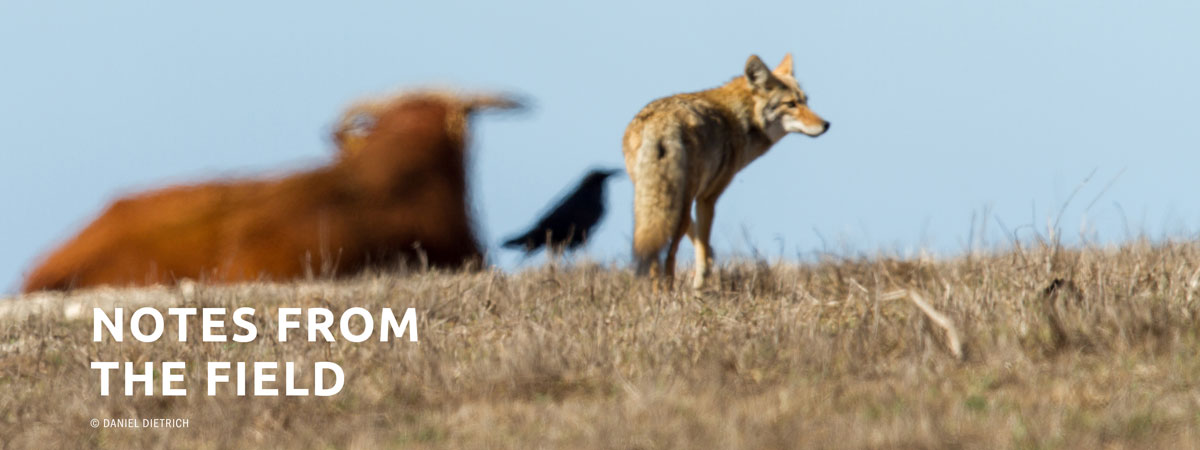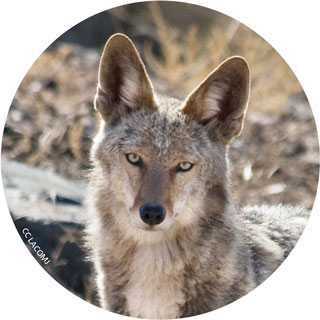Interview With Wildlife Photographer Daniel Dietrich
Daniel Dietrich is a professional wildlife photographer, a certified California Naturalist and owner and founder of Point Reyes Safaris in Point Reyes, California. While his travels have taken him to every continent to photograph wildlife, his love of the Point Reyes National Seashore and its inhabitants has been so strong that he, his wife Jessica and daughters Evelyn and Ruby call it home. His intimate knowledge of the park, its history, and the animal life provide safari guests with a one-of-a-kind experience, encountering coyotes, bobcats, owls, hawks, badgers and more, and always on the animals’ terms.
Daniel is a strong advocate for responsible photography. He will never use bait, lures, calls or any other method of manipulating an animal to view or capture an image. And he has also offered a strong voice at hearings and in his writing for protecting wildlife from contests, bounties and lethal management practices.
You will see many of Daniel’s photographs on Project Coyote’s website and in our video productions, and we always look forward to seeing what new images his lens has found on his journeys.
Project Coyote recently spoke with Daniel about his work and perspectives on wildlife. His stories and perspectives offer an inspiring invitation to appreciate and learn more about the wild animals near us. As Daniel says, “Once you see your favorite animal in the wild, you will want to do all you can to protect it.”
Daniel, how did you get interested in wildlife and wildlife photography?
With one semester standing between me and graduating from university, the thought of starting a job was daunting. I felt like I had to travel before I entered this seemingly new permanent life. I had always dreamed of taking a picture of a koala bear in the wild. So I left school and headed for Australia. I bought a camera at duty free on my way and have been hooked ever since. I captured my koala bear image…and I returned to university a year later and finished my degree.
What have you learned about wildlife and nature from your long hours in their environments?
Respect and patience.
Respect: Our ever expanding human footprint has had a tremendous impact on wildlife. We have made it very hard, and in some cases impossible, for species to thrive and survive. Watching many animals squeak out a living in their shrinking and threatened worlds has had a tremendous influence on me. I have deep respect for the creatures I am fortunate to spend so much time with.
Patience: A great image starts long before the shutter is clicked. Understanding an animal’s behaviors, patterns and demeanor helps tremendously in capturing great images. I will sit for long periods of time with binoculars and scopes. It’s important to watch your subjects intently and learn all you can about them before you photograph them. You will be rewarded with substantially better images.
Describe a typical day of photographing in the field.
I am not sure there is a typical day in the world of wildlife photography! But it always involves a lot of waiting.
In general, I am up before sunrise. I head out into the field and get set up for whatever subject or action I am hoping to capture. If I’ve done my homework, I will already know the particular behavior of my subject. Armed with that information, I will get set up for that particular shot. Then I hope…and wait.
For example, I know a great horned owl pair very well. I may set up in the dark near a favorite roosting spot in hopes of capturing their flight home after a night of hunting. I may set up on an osprey nest in hopes of capturing an adult returning to the nest with a fish. Or I may just sit on the top of a hill with a great expansive view in hopes of watching and learning a particular bobcat’s behavior.
It almost always involves getting out early or staying out late, and a whole lot of patience.
What experience in the field stands out as a memorable highlight?
One afternoon I was out hoping to capture some bobcat images. I found a bobcat walking across a field with a large gopher in its mouth. Normally bobcats eat their meals quickly, so I was curious why this one was on the move with its catch.
Suddenly a coyote burst out from the bushes in full sprint after the bobcat. The bobcat fled for the safety of some trees. Just as the coyote caught up to it, the bobcat launched into a tree and sped up its trunk. It sat on the top branch, gopher dangling from its jaws, as the coyote circled the tree below.
The coyote turned its back and the bobcat launched from the top branch and hit the ground running. The coyote heard the thump, spun around and gave chase again. Just as it caught up to the bobcat, the bobcat dropped the gopher. The coyote put on the brakes and enjoyed the stolen meal.
What has been the most difficult experience?
Seeing animals suffer is always the most difficult thing to deal with. I’ve seen coyotes and wolves with horrible mange. I found an elk with barbed wire wrapped around its antlers and tangled in its legs. I once let a tailgater pass me, only to have the driver smash into a coyote 100 yards in front of me. Just last week I found a dead bobcat on the side of the road, likely hit by a car. Those moments are very difficult.
This year, I spent months with a pair of great horned owlets. I first found them in their nest, just days old. I watched them weekly as they grew stronger and eventually fledged. I fell in love with their distinctly different personalities. One day I found only one. Same the next day. I knew something was wrong. As I wandered the trees where they roosted, I found the remains of one of them. It was heart breaking. I felt like I had lost a friend. I realize this is nature, but that one really stung.
Based on what you’ve observed, how do predators such as wolves, foxes, bears and coyotes fit into your understanding of the natural world?
These apex predators and keystone species are the very things we need for a healthy and vibrant ecosystem. They are vital to our own existence. We as humans like to put things into boxes. These animals do this. Those animals do that. And if one acts differently than the box we put them in, then something must be done. We ‘manage’ wildlife in such a simplistic manner. Problem wolves? Kill some. Too many coyotes? Shoot some.
The natural world is much more complex. We need to view the natural world as a complete system. We need to better understand that killing one apex predator such as a bear has far reaching consequences that outweigh satisfying a temporary ‘management’ need.
Do you have a favorite species to photograph?
I have fallen in love with photographing bobcats. They are a perfect predator and are always exciting to watch. They are well camouflaged, so are difficult to find. They are shy, making them very hard to approach. They are powerful; just watch one stalk and take down a rabbit or a gopher. They are stunningly beautiful. The combination of all these things makes finding and photographing one a truly amazing experience.
What in your view is the greatest threat to the interests of wildlife?
Our governmental agency, Wildlife Services. This agency has spent hundreds of millions of taxpayer dollars to exterminate millions of animals, mostly at the behest of special interest groups such as hunters and ranchers.
If you could suggest one thing people could do that would benefit wildlife, what would that be?
I would ask them, “What is your favorite animal?” If they have never seen that animal, I would tell them, if possible, go see it in the wild. Once you see your favorite animal in the wild, you will want to do all you can to protect it.
Then I would tell them to volunteer with an organization who shares your love for that animal. Find your cause. Delisting of grizzlies. Killing contests. Trapping. There are so many. Commit to making a difference.
What else do you think people should know about wildlife?
In my career as a wildlife photographer, ethics are of the utmost importance to me. We all love wildlife images. They move us. They put us in a place where we may never get to ourselves. They tell amazing stories. But there is a lot of unethical behavior behind many of the images we admire so much. Many photographers use bait to capture their images. They buy mice at the pet store and throw them onto the ground to capture images of owls. They kill a deer, place it out in a field and take photos of wolves from a blind as they approach. They throw fish out into the water to lure in eagles. These unethical behaviors put our wildlife at risk. Be sure to know the stories behind these images before you support those who are taking them.
You can see more of Daniel’s images on his website and read more stories on his blog. You can also learn more about how science disproves the lethal practices of Wildlife Services, and see video clips about the ecological value of predators here and here.







